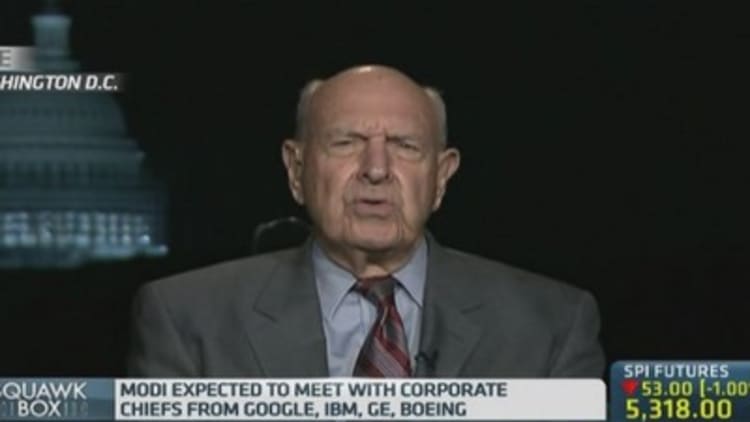Indian Prime Minister Narendra Modi launched his 'Make in India' campaign with great fanfare on Thursday, including an impressive website and eye-catching logo, but more must be done before it takes off, analysts say.
Modi unveiled the initiative aimed at reviving the manufacturing sector through higher domestic and foreign participation ahead of his first official visit to the U.S.
Key aspects of the framework include time-bound project clearances through a single online portal, an eight-member team dedicated to answering investor queries within 48 hours and addressing key issues including labor laws, skill development and infrastructure.
Under the campaign, the government aims to raise the manufacturing sector's share of gross domestic product (GDP) to 25 percent in the next decade from around 15 percent currently.
Read MoreNext stop in Modi's global PR campaign: USA
Elements of success
The initiative highlights the government's determination to build investor confidence and increase investments, economists say, but success hinges on the pace at which infrastructure investment is undertaken, the availability of skilled labor and amendments to land acquisition legislation.
"While the 'Make in India' campaign is a step in the right direction, it will have to be followed up by more tangible measures such as building ports, highways, increasing power generation and so on, to make India a manufacturing hub," Sonal Varma, chief India economist at Nomura wrote in a note.
Poor infrastructure remains a major deterrent for foreign investment in Asia's third largest economy, which ranked 85 out of 148 for its infrastructure in the World Economic Forum's 2013-2014 Global Competitiveness Report.
While it's reassuring to hear the government has a plan, "Make in India" feels like a marketing tool, said Shishir Sinha, research analyst for Frontier Strategy Group, a consulting firm focused on emerging markets.

"Even though companies would enjoy manufacturing in India given its large base of low-cost labor and engineers, it still takes way too long to acquire land, it is difficult to hire and fire labor, the taxation differs too much across the various states, and lack of infrastructure make the overall cost of producing much higher," he said.
In order to spur wide-scale industrialization and convert the huge levels of interest into investment, the government needs to implement major reforms on these fronts, he said: "We need to see fundamental actions from the government to see action from the private sector."
Label wars?
It will take time before "Made in India" gains ground on "Made in China," analysts say.
Read MoreUS to press India on trade row during Modi's Washington visit
"China is unlikely to lose its dominant position as the 'factory of the world' anytime soon because of its well-established infrastructure, existing manufacturing facilities, ability to scale quickly, and strong involvement in established global supply chains," said Sinha.
"However, certain low value-added industries are likely to consider moving out of the country or at least setting up their next facility in India, where the cost of labor can be less than half of that in coastal China. Engineers also come much cheaper in India than most places in the world," he added.
But keep in mind that India is not just competing with China for overseas investment, said Sinha, pointing to Southeast Asian nations including Vietnam and Thailand.
Read MoreAre China-India ties entering a new chapter?
"ASEAN countries provide cheaper labor, investor-friendly governments, and are part of established supply chains," he said. "[They] also provide access to several raw materials, and certain locations have strong linkages to trade infrastructure."


